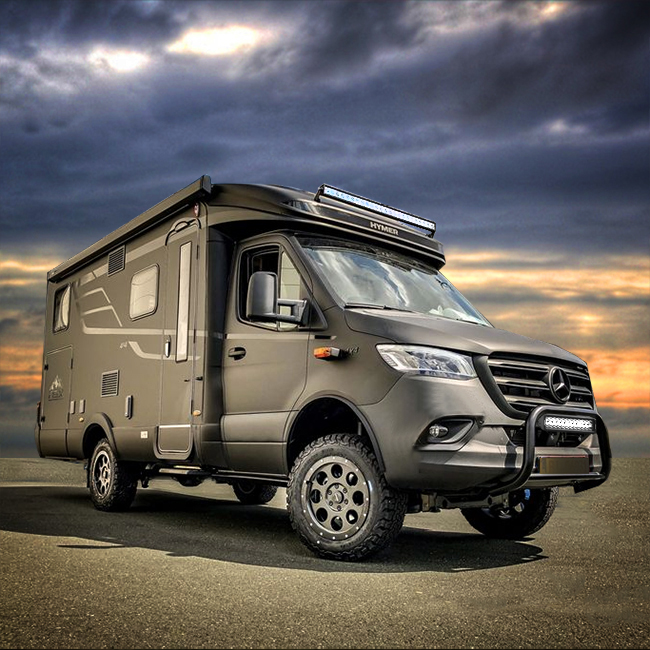This page contains equipment which we assume is not generally known, but which we believe should be present in every vehicle.
Lights
Osram Value Series Lightbars

Lightbars provide a far-field lighting coverage which keeps us aware of potential obstacles by using a functional, useful beam pattern. Wether we’re navigating dark country roads, forest paths, off the beaten tracks, off-road and on-road- these OSRAM LEDriving Lightbars will keep us safe.
- With its 24 LEDs, the VX250-CB (with a 25cm effective lightbar) delivers up to 2100 lumens and has a mid-to-long range of up to 170 meter.
- The VX1250-CB (with a 125cm effective lightbar) has 45 LEDs, delivering up to 8000 lumens and a far-field range of up to 590 meters.
Even in dim light and reduced visibility due to external environmental influences, the driving light with up to 6000 Kelvin can provide conditions similar to daylight. The power package scores with highest optical efficiency and homogeneous light distribution and a long service life with up to 5000 hours. With an aluminium housing and the stable polycarbonate lens, it is particularly light and at the same time robust and resistant. It has been tested and validated with the IP-Protection Class IP67 for extreme external influences regarding water, dust, impacts, heat, cold and permanent vibration. It is protected against damage from overheating and polarity protection. Bottom and side mounting sets are included, the wiring harasses (for either 1 or two lights) are optional.
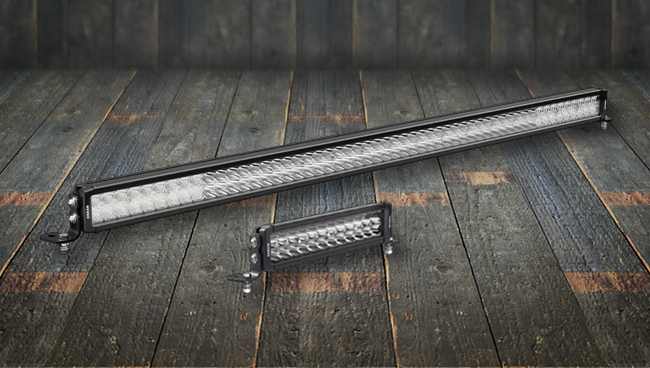
& VX250-CB
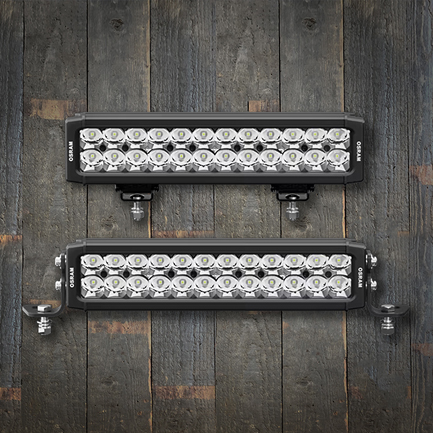 VX250-CB Lightbar mounts | 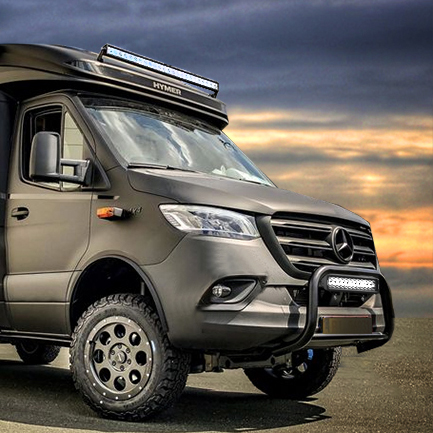 VX1250-CB (cabin top) & VX250-CB (Bull rack) Lightbars |
Breakdown, Safety & Emergency Gear
Osram BATTERYjumpstart 1000
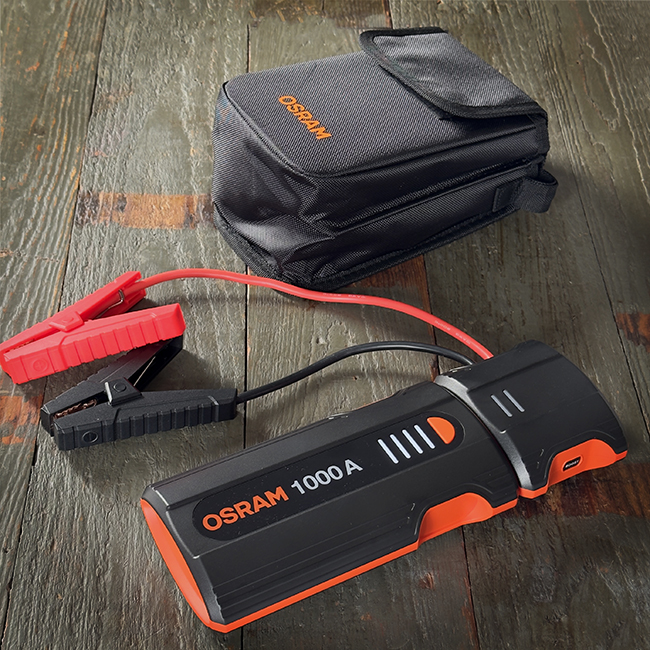
The OSRAM BATTERYjumpstart 1000 can jump-start vehicles with engines up to 5L Petrol or 2L Diesel. With 1000A starting power, it is suitable for most 12V cars, vans, SUVs and Motorhomes. The boost function enables jump-starting of completely depleted batteries. The unique ergonomic smart clamp connection features longer cables for better accessibility in hard-to-reach areas. Safety features include reverse polarity protection, anti-spike protection, and short circuit protection, with audible and LED indicators. An integrated torch illuminates the work area, and LED indicators show the current battery level. The unit features PD30W fast charge technology for quick charging and powerful charging of mobile devices via the USB C and USB A ports.
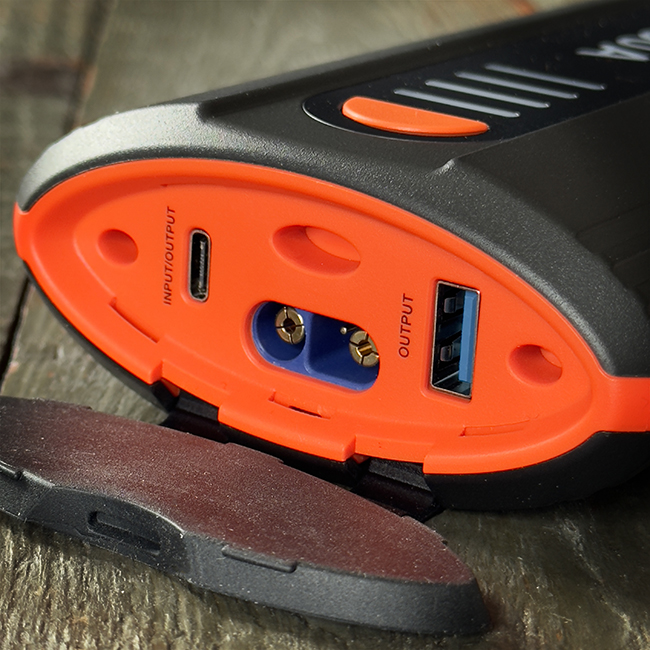
Tire Pressure Monitoring System
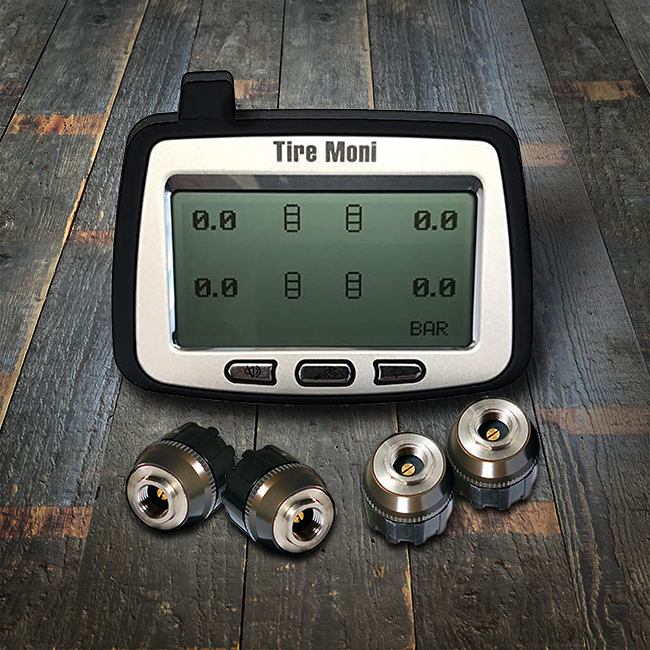
A Tire Pressure Monitoring System (TPMS) shows the current air pressure in all tires, on a display, while driving. So we can monitor deviations and will be warned immediately in the event of a pressure loss.
We use the TireMoni tpms TM-240 eco package: The package contains a display, 4 sensors, four short metal valves series ASC-31 and 4 spare batteries CR1632: Ready to be installed. ‘Installation’ meaning: mounting the 4 sensors on the tire valves and setting the parameters you prefer on the display. The sensor batteries will last 1-2 years (@ 4h driving time/day).
From July 2024 many new vehicles are obliged to have a Tire Pressure Monitoring System by European law. This legislation is not aimed at motorhomes or campers, but driven primarily by safety and reducing greenhouse gas emissions, which should be ample reason to have them on your vehicle.
Incorrectly inflated tyres wear faster and waste fuel, as well as being at risk of unexpected failure.
These are the reasons for using a tpms:
- Safety
A partially- or entirely deflated tire has big consequences for the handling, steering and breaking of the vehicle. It might also be an early warning for a blow-out. - Reduced emissions
Incorrectly inflated tyres run inefficiently and thus enhance greenhouse gas emissions. - Less fuel consumption
Correctly inflated tires have less fuel consumption and thus cost less to drive.. - Tire wear
Incorrectly inflated tyres increase tire wear and thus decrease the lifespan of tires, thus resulting in higher cost. - Ease of use
The use of a TPMS is, by far, the easiest (and least dirty way) to monitor tire pressure.
Installation
It took me approximately 10 minutes to install the system, both tire- and monitor components (using the sigarette lighter power supply). Initially I set the minimum and maximum pressure values at half a bar up and down from to the tire specs. After a couple of rides, I was able to set them more accurate, incorporating temperature changes. Out of the two, the pressure indication seems more accurate than the temperature value, but this is probably due to the sensors being valve-mounted. Temperature as relative trend observation is still very usefull.
I do advice to check alignment and balance after installing a tpms system. (The sensors had no significant influence on the alignment and balance of my wheels, though.)
Offroad usage scenarios
Although not daily, I also use my car off-road, where tire pressure is an important tool in addition to the environmental aspects. Lowering tire pressure in sandy conditions to prevent digging in, on gravel, sand or mud to make the tires slide less. It reduces damage to the tires and finally, an off-road ride is usually more comfortable with lower tire pressure. I use these basic rules as a starting point:
- Gravel roads: 20% less than normal tire pressure recommended. This depends on the road condition and the speed of the vehicle.
- Rocky terrain: around 30% of normal pressure. This ensures maximum traction and protection against sharp edges.
- Sand: around 40% of normal pressure. This prevents the vehicle from sinking and offers the best performance.
- 100%: On the asphalt I naturally use the tire pressure recommended by the supplier.
the TireMoni TPMS is of crucial importance to us when monitoring the correct tire pressure!
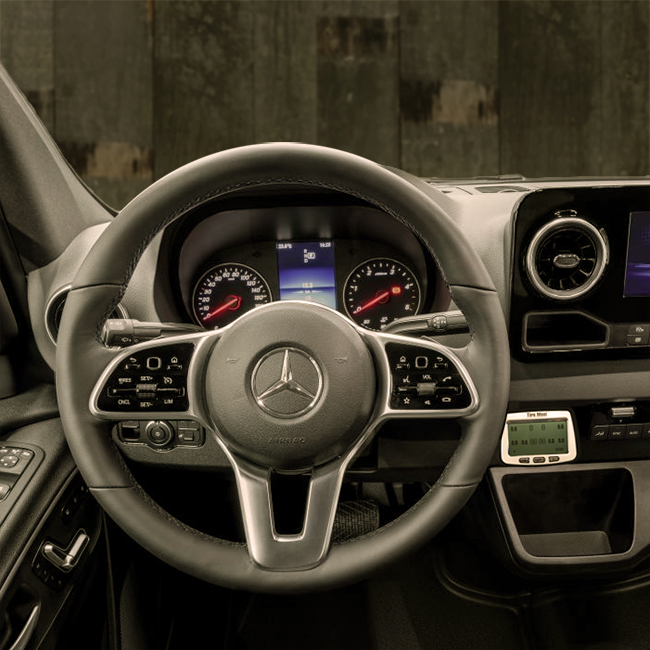 Display on bottom-right. Display on bottom-right. | 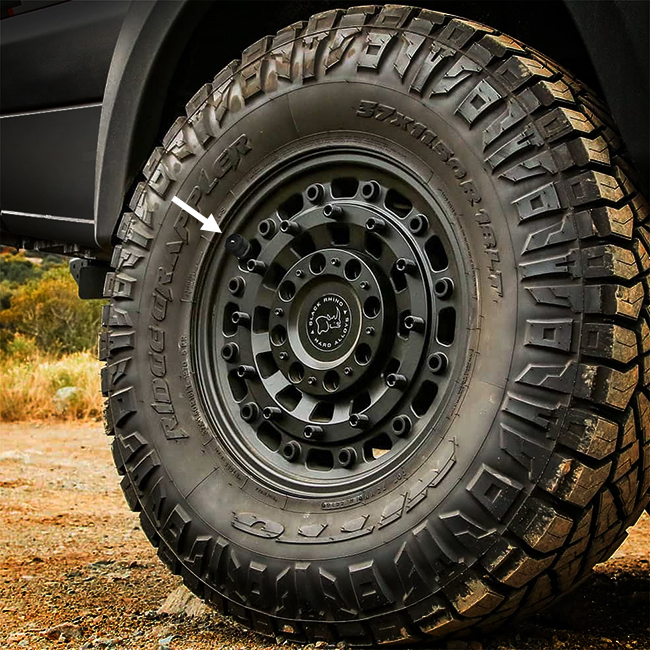 The Inconspicuous/Discrete Tiremoni Sensor. The Inconspicuous/Discrete Tiremoni Sensor. |
Element Fire Extinguishers
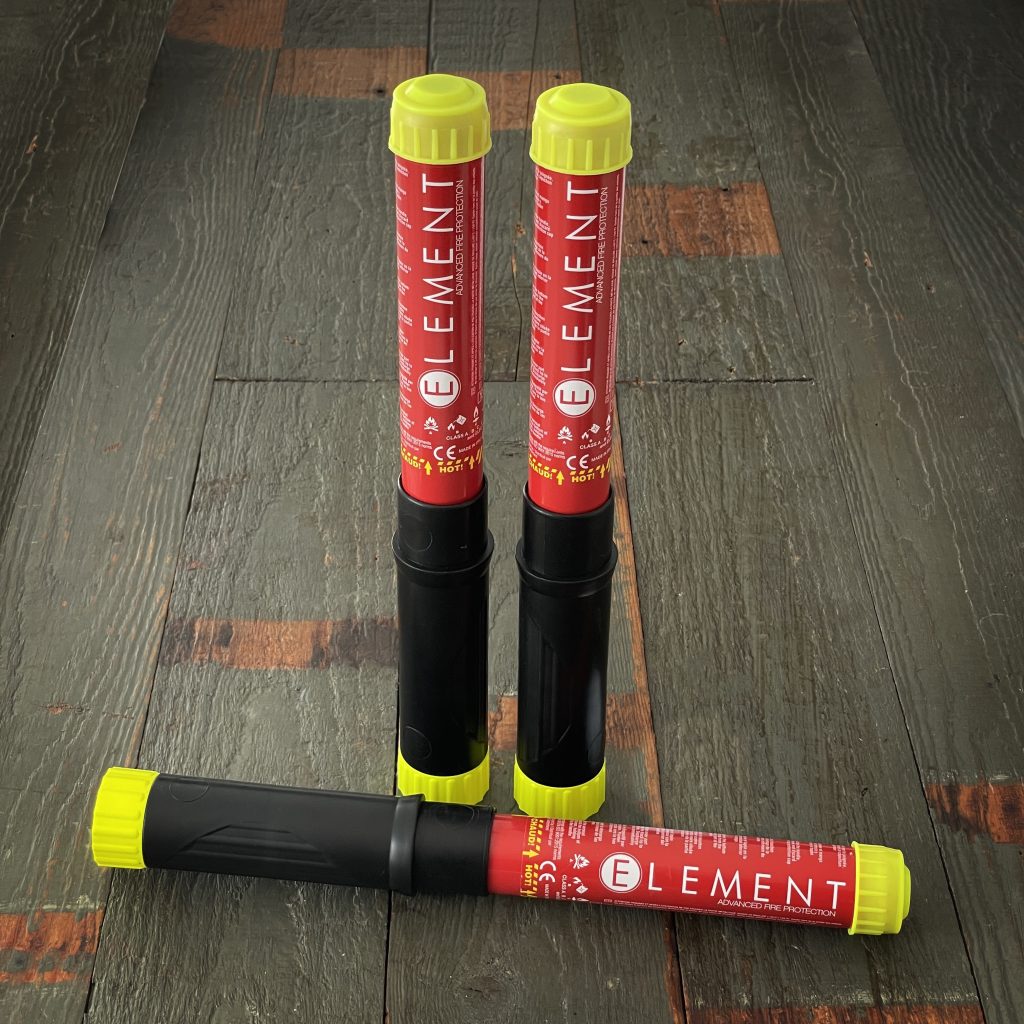
Our camper is equiped with 3 of these Element E100 Fire Extinguishers. We have them strategically placed:
- on the back of the front passenger seat (reachable both from the kitchen as from the cockpit).
- near the bed.
- in the rear garage.
How the Element E100 Fire Extinguisher works.
The Element fire extinguisher works by your activating a process that chemically disrupts the oxygen that a flame needs. Because of the way the process works, it doesn’t create a mess and can work on all types of fires. A chemical reaction and resulting Potassium Nitrate vaporization create a gas that is heavier than air and smothers a fire. A direct line of sight to a fire is not required to extinguish it. For example, an under-dash or underhood fire could be put out by fogging under the dash or through grill vents, with the heavy gas acting as sort of a blanket, and putting out the fire. Element extinguishers can get wet with no ill effects, but should not be submerged for an extended period.
The best way to show why these are the very best fire extinguishers for this purpose is by comparison :
| Element E100 Fire Extinguisher | ‘Conventional’ Fire Extinguisher (2 liter) |
|---|---|
| 100 second discharge | 9-10 seconds discharge |
| 360 grams | more than 4 kg |
| 33cm tall, 4cm diameter | 45cm tall x 13cm diameter |
| Non-toxic, | Often toxic (some of them can cause cancer) |
| Non-corrosive, environmentally friendly | Often corrosive & polluting |
| Leaves No mess | • Dry chemical fire extinguishers leave behind a corrosive powder that needs to be cleaned quickly. • Wet chemical extinguishers discharges a fine mist leaving a residue that needs to be cleaned. • Foam fire extinguishers leave a residue that can cause cancer and should be cleaned wearing protection. |
| Zero thrust discharge: Will not spread oil & liquid fires | Strong thrust discharge: Will spread oil & liquid fires |
| Maintenance free | Requires maintenance |
| No expiration date | Expires after 5 years |
| No moving parts | Moving and vulnerable parts |
| Fights all major fire classes: A,B,C, F/K and Electrical. (wood, coal, paper, flammable liquids & gases, electrical, and cooking oil/grease) | There are eight different types of fire extinguishers to choose from, like specialist dry powder, standard dry powder, foam, water spray, water mist, water spray, wet chemical and carbon dioxide. |
| A direct line of sight to a fire is not required. | A direct line of sight to a fire is required. |
| Very easy to operate. | Complexer to operate |
| One hand operation possible | Two hand operation required |
| It will work. | It might not work! (read below) |
Why your conventional fire distinguisher might not work. Your fire extinguisher might not work, even if the dial on the extinguisher is in the green. The shaking of a camper can compress the material in the fire extinguisher. There may be pressure still in the extinguisher, but it can’t distribute the now-hardened material. Condensation can occur inside the fire extinguisher which turns the powder into something like concrete. Again: There may be pressure still in the extinguisher, but it can’t distribute the now-hardened material.
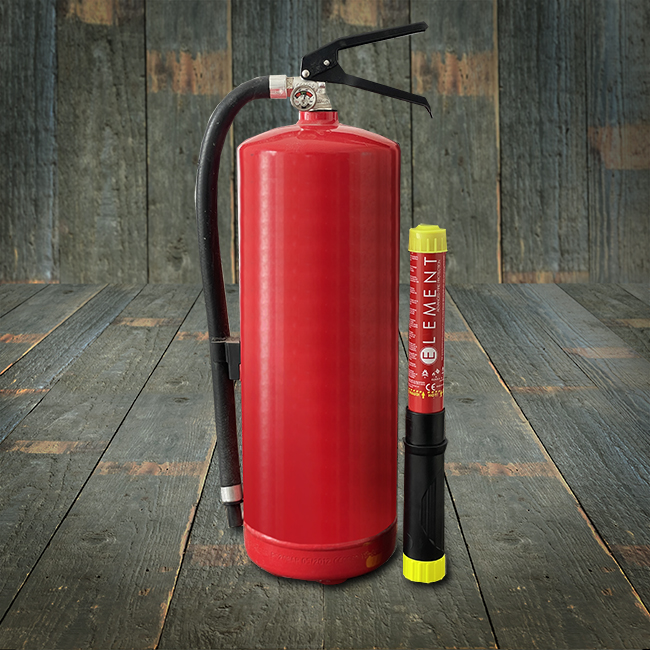
Right: Element, 100 sec. discharge, weighs 0,35 kg.
Osram LEDguardian ROAD FLARE Signal
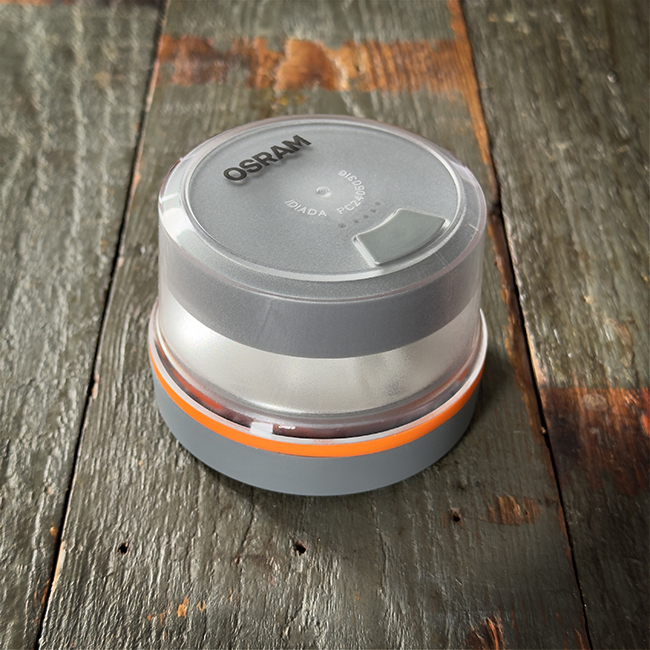
The Osram LEDguardian ROAD FLARE Signal V16 IoT is a regulatory warning light that is certified, approved and connected to the DGT 3.0 network in Spain. Its use will be mandatory in Spain starting January 1, 2026, replacing the current warning triangles. The warning light with an integrated SIM card, anonymously transfers data, signalling the vehicle’s position without the need for the driver to get out of the vehicle. This enables real-time localisation and transmits immediately crucial information about a potentially dangerous situation in road traffic to other drivers’ navigators and to nearby variable public information panels. Equipped with a magnetic attachment, battery indicator, and a 9V battery included, it’s designed for quick and fast mounting. With a simple on/off switch, this energy-efficient warning light offers a long lifespan and modern design, making it an essential addition to your road safety kit.
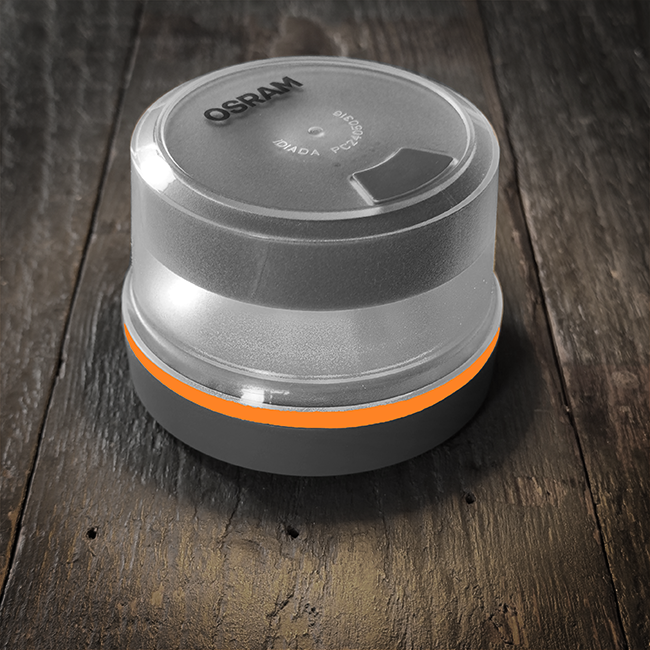
Osram STARTERcable 700A

The OSRAM STARTERcable 700A is a high quality starter cable, made of copper coated aluminum which reduces the resistance of the cable and allows a constant and effective transmission of the charge. Thanks to the 3.5 meters length and the 25mm² cross-sectional area, it is possible to start vehicles with petrol and diesel engines with up to 5.5 liters of displacement. It is suitable for voltages of 12V and 24V. To prevent high wear and tear, the cable is sheathed in flexible yet durable PVC, the insulated clamps and handles provide additional safety and durability. The different colors of the cables and the handles on the clamps reduce the risk of mixing up the positive and negative terminals and thus the risk of incorrect connection to the battery. The storage bag has the operating instructions attached to the back.
Coolado Air Pumps
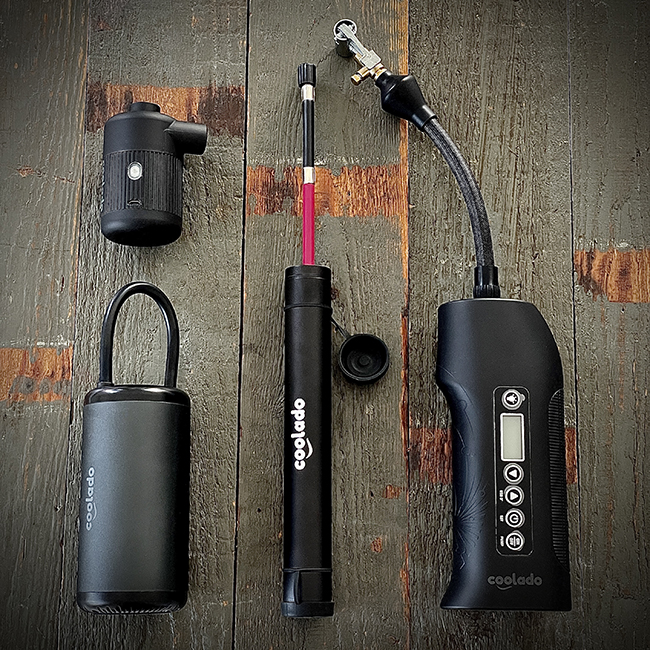
bottom: tPumpX, tPumpP & tPumpXL
On-Board Diagnostics (OBD) Tool
Most cars and thus campers as well, have an OBD diagnostic connector, underneath the dashboard, within approximately 60cm grom the steering wheel. These connectors facilitate the use of hand-held and/or mobile device-based scan tools. These tools make use of vehicle’s self-diagnostic and reporting capability. OBD systems give access to the status of the various vehicle sub-systems. This means you can check what a possible warning light on your dash really means and you can run pre-departure checks.
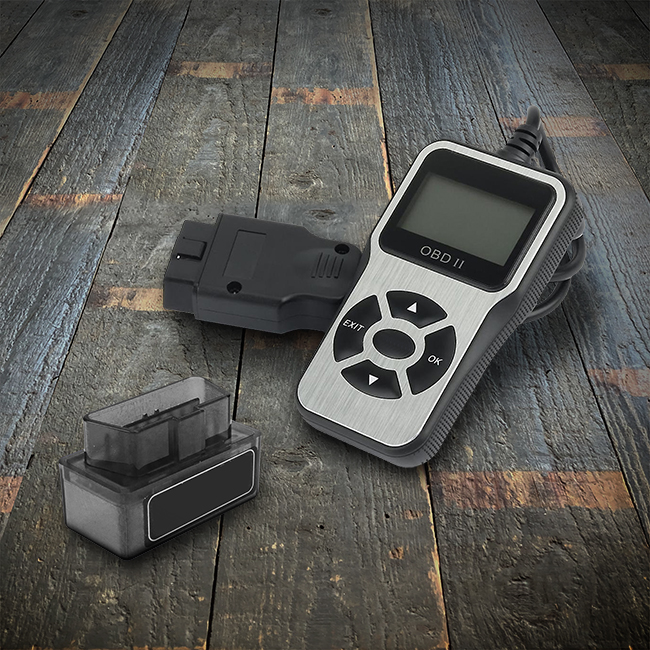
Back right: Handheld device
Hand-held scan tools and Mobile device-based scan tools, basically can have the same functionality
Hand-held device plug directly into the OBD connector, whilst Mobile divice based tools rely on a bluetooth connector that connects with your personal mobile device.
Multimeter

Multimeters can be used to test for voltage drop at various circuits, blown fuses, current draws, heating elements, and to verify bad cable connections.
The most common task is checking pedestal voltage (the powersupply on the camping.
Battery and charging system testing is another popular use for the multimeter.
Another use for multimeters is to test for current draw. If your RV loses battery power while parked, you may have a current draw some place that needs to be dealt with. Battery cables and wiring sometimes suffer from bad connections. A terminal connector may have a bad crimp, a wire may have pulled out of the connector, or corrosion may be affecting the ability of the wire to transfer current. By placing one meter probe on one end of the wire and the other probe on the far end of the wire, you will be able to determine the voltage drop or loss as the current passes through the wire.
Fuses are another common test. You can use the DC voltmeter setting if the fuse is in the holder and the circuit is powered. You should have power at the input side of the fuse. If the fuse is good, you will have power at the output side, as well, but you will only have power on the input side if the fuse has blown.
The tPump XL is the ultimate double ‘pressure pump’. An air compressor capable of pressures up to 6.9 BAR / 100 PSI, at up to 40 liters per minute. In depth information on all my pumps can be found on the Multifarious page.
Other Breakdown & Emergency Gear
- Air pressure gauge for tyres
- Repair spray for tyres
- Wheel wrench
- Car jack
- Snow chains
- Jump Starter
- Jump leads
- Tow rope
- Warning triangle
- Emergency Flair
- High-vis vests
- Flashlight/headlamp
- Work gloves
- Tool Kit
Adapter Sets
Euro Power Supply adapters
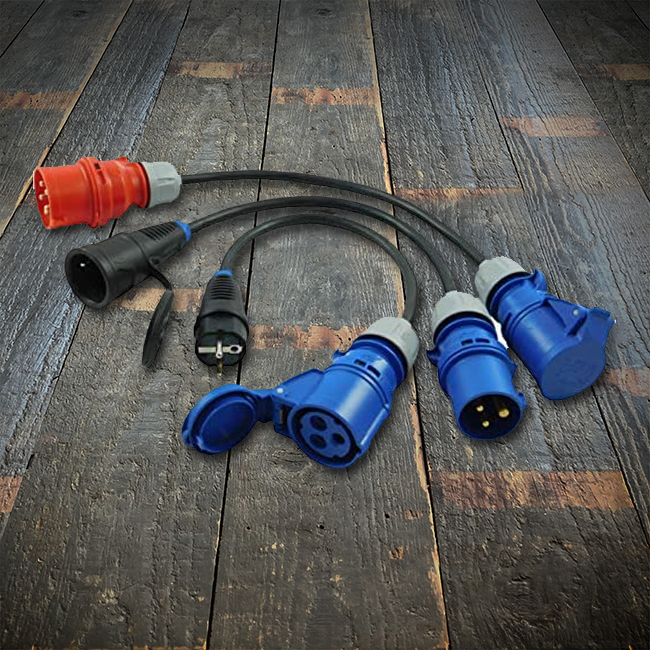
On campings throughout Europe CEE sockets (CEE 230v 16A Sockets) are the standard. Occasionally only standard (domestic) earthed wall sockets are available. We carry a set of adapters covering all possible combinations, so this includes all European domestic Chuco plugs.
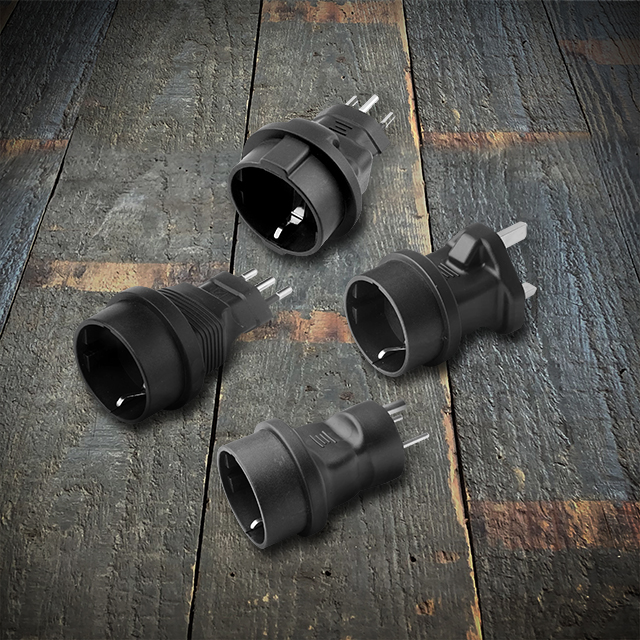 Schuko Adapter Set Europe | 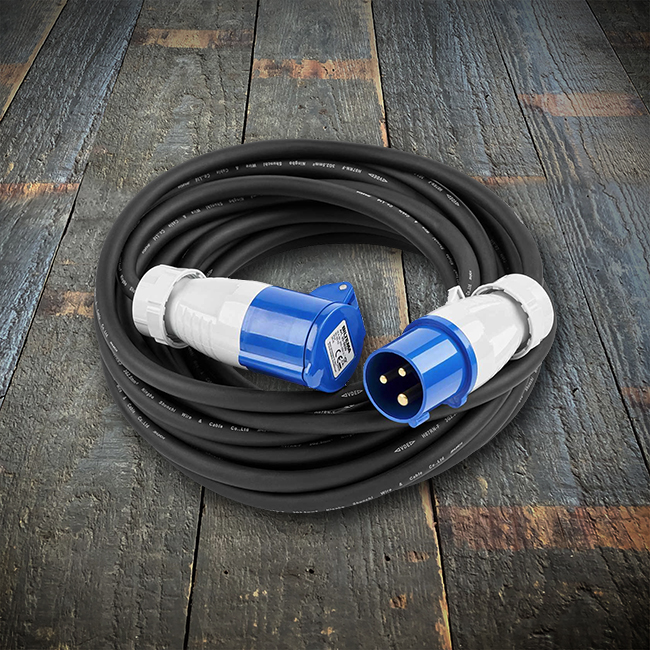 CEE Extension cable |
The connected extension cable needs to comply with the following requirements:
- The heavy rubber hose line is H07RN-F compliant.
- It may not exceed a length of 25 meters.
- The right wire diameter is at least 2.5 mm² for a rated current of 16 A.
- Cables in signal colours, ensure more safety and prevent people from overlooking tripping hazards.
Gas Filling and Tank Adapter Sets
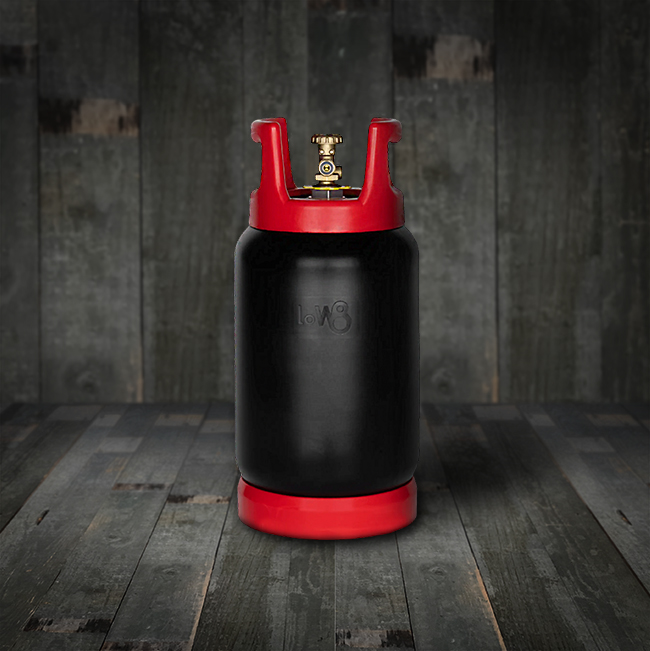
We used to carry a myriad of the most obscure adapters and even gas tanks. We are strictly propane users, because we do a fair bit of winter camping as well. Recently we have been informed about loW8 gas tanks. These ultra lightweight composite cylinders are the best available. They can be filled throughout Europe, so we will pack a Europe filling adapterset, to fill gas tanks with shell/din connection.
Our better-safe-than-sorry set contains:
- A set of reducers/adapters to be able to use bottles from various European countries in our camper.
- 30 and 50 bar pressure regulators
- Spare hoses, connectors and hose clamps.
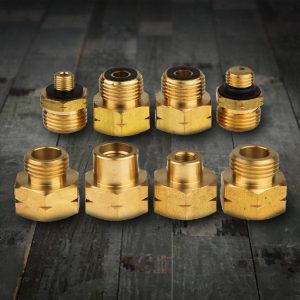
Bottom: Europe Filling Adapter set.
Waterconnectors
- Waste Water Hoses
- Clean Water Hoses
- Connectors and Clamps
- Filling/Garden Hose
- A Gardena quick connect adapter set suitable for taps with 26,5mm (G 3/4″) taps and 13 mm (1/2″) and 15 mm (5/8”) hoses.
Spares
- Replacement bulbs
- Replacement fuses
- Replacement water pump
- Gas hose ad clamps
Security Gear
- Anti-theft devices
- Intruder alarm system
- Smoke/fire alarm
- Camera system
- Fire extinguisher
- First aid kit
